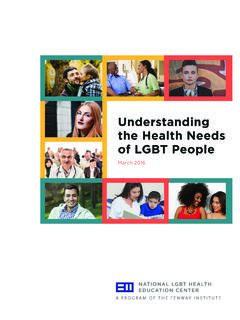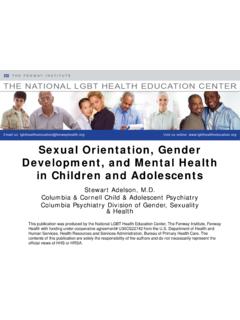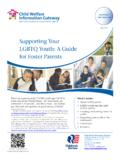Transcription of PROVIDING INCLUSIVE SERVICES AND CARE FOR …
1 A Guide for Health care StaffPROVIDING INCLUSIVE SERVICES AND care FOR LGBT PEOPLENATIONAL LGBT HEALTH EDUCATION CENTERA PROGRAM OF THE FENWAY INSTITUTE i Table of Contents The Importance of Affirmative and INCLUSIVE Health care for LGBT people .. 1 Part 1: Gaining a Better Understanding of LGBT people .. 3 Concepts and Terms .. 3 Barriers to care for LGBT people .. 5 Limited Access .. 5 Negative Experiences .. 5 Lack of Knowledge .. 5 Common Health Issues Among LGBT people .. 6 The Challenge of Creating an INCLUSIVE Environment for LGBT people : Two Case Scenarios .. 7 Part 2: Strategies for Health care Staff .. 8 Expectations .. 8 Practical Thinking .. 8 Communication Basics .. 9 Pronouns and Preferred Names .. 9 What to Do When the Name and Gender on Records Do Not Match .. 10 Avoid Asking Unnecessary Questions .. 10 Understand Diversity and Fluidity of Expression .. 11 Maintaining a Non-Judgmental Attitude.
2 11 Practicing Making LGBT people Comfortable .. 11 Create an Environment of Accountability .. 11 We All Make Mistakes, .. 11 Putting it All Together - Solving Problems on the 12 Conclusion .. 13 Part 3: Helpful Resources .. 15 Resources .. 16 General References .. 17 Glossary .. 18 Communication Best Practices .. 21 1 PROVIDING INCLUSIVE SERVICES and care for LGBT people : A Guide for Health care Staff The Importance of Affirmative and INCLUSIVE Health care for LGBT people A visit to a health care facility can make people nervous for any number of reasons. Some people may be uncomfortable revealing sensitive information to health care professionals who need it to provide certain SERVICES . Others find it difficult to talk about private health concerns. Creating an environment in which these conversations are more comfortable for the patient is an important goal for all health care staff.
3 Because health care is for everyone, we must be prepared to serve people of all races, ethnicities, religions, ages, and backgrounds. When people have bad experiences with health care staff simply because they are (or seem) different, they may hide important information about themselves or worse, they may not return for needed health care . This guide has been developed to help health care staff provide an affirmative, INCLUSIVE , and respectful environment for all clients, with a focus on lesbian, gay, bisexual, and transgender (LGBT) people . Many LGBT individuals have difficulty finding health care where they feel included and accepted. Negative encounters can occur with any staff member LGBT people meet, from the time they arrive for a visit until the time they leave. These incidents could happen with a security guard, receptionist, nurse, case manager, medical assistant, doctor, or other health care provider.
4 Some LGBT people have reported being refused care because they are LGBT. Others say they have overheard jokes or slurs, or have received insensitive criticisms about their appearance or behavior. In many cases, problems arise from simple oversights or mistakes made by well-meaning staff who lack understanding about how to interact with LGBT people . For LGBT people who have experienced stigma and discrimination during their lives, even small mistakes can bring up past negative experiences. These feelings can affect their willingness to seek health care again. Unless we communicate with knowledge and understanding about the health concerns, barriers to care , and other needs that are common among LGBT people , they may not get the SERVICES they need. LGBT people are very diverse. In addition to being LGBT, they may be any race or ethnicity, rich or poor, speakers of English or other languages, and in families that are or may not be religious.
5 All of these factors, and others, can affect their health care experience. In order to provide SERVICES and care to LGBT people in the most effective way, health care staff must be able to understand how LGBT people s identities, experiences, and relationships with the world around them might affect their health. In addition, many non-LGBT people have LGBT family members, and may feel hurt if their family members are not respected. Making LGBT people and their 2 families feel safe and included can lead to a more trusting relationship with health care providers, and improved communication about their unique needs for care . To help all of us provide the health care LGBT people need, this guide will cover LGBT terms and concepts as well as some common health concerns. It also includes recommended practices for communicating with LGBT people , PROVIDING them with good customer service, and creating a safe, affirming, and INCLUSIVE environment.
6 As we will see, these practices can help provide better SERVICES for everyone else as well. Here s What You ll Find Inside: Part 1 provides background information on LGBT people and their health needs. Part 2 provides tips and strategies to improve communication and create a more affirming and INCLUSIVE environment. Part 3 includes helpful resources, a glossary of terms, and additional information about how to care for LGBT people . 3 Part 1: Gaining a Better Understanding of LGBT people In this section, we will introduce basic concepts and terms that may be helpful in developing a common understanding and good communication with LGBT people . More terms can be found in the Glossary included in Part 3, Helpful Resources. Concepts and Terms We begin with two concepts: sexual orientation and gender identity. All people have a sexual orientation and a gender identity. Sexual orientation and gender identity are not the same thing.
7 Sexual orientation tells you how a person characterizes their sexual and emotional attraction to others. Common words to describe sexual orientation are: Heterosexual (straight) is a sexual orientation that describes women who are emotionally and sexually attracted to men, and men who are emotionally and sexually attracted to women. Gay is a sexual orientation that describes a person who is emotionally and sexually attracted to people of their own gender. It is more commonly used to describe men. Lesbian is a sexual orientation that describes a woman who is emotionally and sexually attracted to other women. Bisexual is a sexual orientation that describes a person who is emotionally and sexually attracted to people of their own gender and people of other genders. Some people describe their sexual orientation in other ways. For example, some people use terms such as queer, pansexual, same gender loving, or same-sex attracted.
8 Others are attracted to and have relationships with people of the same sex, but prefer to call themselves heterosexual. This may be because they fear a negative reaction from others, but sometimes it is because their culture does not recognize gay, lesbian, or bisexual sexual orientations. It is important to keep in mind that some people desire to be with someone of the same sex, but have not acted on this desire, and may want to discuss their feelings. Sometimes health care or research professionals do not use terms like gay or lesbian to describe people , but focus instead on their sexual behavior. They use terms like men who have sex with men, abbreviated as MSM, or women who have sex with women (WSW), or use the phrase sexual and gender minorities (instead of LGBT). The glossary in Part 3 defines many of these terms. Later in this document, we will learn how to let LGBT people describe themselves using language they prefer.
9 This freedom of expression is important, particularly when communicating with people from cultures that do not accept gay, lesbian, or bisexual identities and may want to use other terms. Gender identity is a person s internal sense of being a man/male, woman/female, both, neither, or another gender. Most people have a gender identity that is the same as the sex they were assigned at birth ( , a person assigned female at birth and who identifies as a woman). 4 However, some people have a gender identity that does not correspond to the sex they were assigned at birth. We use the term transgender to describe these individuals. The term transgender describes a wide range of people , including the following: A transgender man is someone who was assigned female at birth and who identifies as a man (some use the term female-to-male, FTM, or transmasculine). A transgender woman is someone who was assigned male at birth and who identifies as a woman (some use the term male-to-female, MTF, or transfeminine).
10 Other people have a gender identity that falls outside of the traditional gender binary of male and female. They may identify as both male and female, or as another gender, or their gender identity may change over time. Some use the terms genderqueer or gender fluid or something else to identify themselves. Gender expansive perspectives are increasing among young adults and adolescents. Keep in mind that transgender people can have any sexual orientation, including heterosexual, gay, lesbian, or bisexual. Many use other terms to describe their sexual orientation. Transgender people often transition the way their body looks in order to affirm their gender identity. For example, many change their name, clothes, hair style, way of walking, etc. They may also take cross-sex hormones or have surgery to change the appearance of their bodies to match their gender identity. Transgender people may look dramatically different if you knew them before and after they transition or affirm their gender.
















